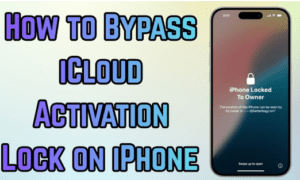In our fast-paced digital world, your iPhone is more than just a communication device—it’s a treasure trove of memories, important documents, and countless apps that make life easier. But what happens if disaster strikes? Whether it’s a sudden software glitch or an unexpected drop into the pool, losing your data can be catastrophic. Fear not! In this guide, we’ll show you how to safeguard everything on your device with two easy and efficient backup methods: iCloud and Mac. With these simple steps, you can rest easy knowing all your precious photos, messages, and contacts are securely stored and easily retrievable. Let’s dive in and transform uncertainty into peace of mind!
Introduction to iPhone backups
Your iPhone is more than just a device; it’s a treasure trove of memories, important documents, and everyday essentials. The thought of losing all that data can be daunting. That’s where backups come into play. Understanding how to back up your iPhone is crucial for safeguarding your digital life.
Whether you prefer the convenience of cloud storage or the tangible reassurance of a Mac backup, knowing your options empowers you. With just a few simple steps, you can ensure that photos from last summer’s vacation or critical work files are safe and sound. Let’s dive into everything you’ll need to know about backing up your iPhone to iCloud or a Mac so you can enjoy peace of mind every day!
What is iCloud and how does it work?
iCloud is Apple’s cloud storage service designed to keep your data safe and accessible across all your devices. It allows you to store photos, documents, backups, and more in a secure online space.
When you activate iCloud on your iPhone or other Apple devices, it automatically syncs information like contacts, calendars, and notes. This means any changes made on one device reflect instantly on others.
The storage works seamlessly with the internet. As long as you’re connected, you can access files anywhere—whether at home or on the go.
You get 5GB of free space initially but can opt for larger plans if needed. The beauty lies in its convenience; no more worrying about losing important data during upgrades or mishaps. With iCloud backing up most of what matters to you automatically, peace of mind is just a few taps away.
Setting up iCloud backup on your iPhone
To set up iCloud backup on your iPhone, start by opening the Settings app. Tap on your name at the top to access Apple ID settings. From there, select “iCloud,” which will take you to a range of options.
Next, scroll down and tap on “iCloud Backup.” You’ll see a toggle switch that allows you to enable this feature. Make sure it’s turned on; this is crucial for automatic backups.
Once enabled, you can also choose “Back Up Now” if you want to initiate an immediate backup. Your device needs to be connected to Wi-Fi and plugged into power for seamless backups.
Ensure you’re using enough iCloud storage space as well. If necessary, consider upgrading your plan directly through the settings menu if you find yourself running low on available space.
Benefits of using iCloud for backups
Using iCloud for backups offers unparalleled convenience. With just a few taps, your entire iPhone can be securely backed up automatically. This means you won’t have to worry about manually transferring files or forgetting to do it altogether.
Another significant benefit is accessibility. Access your data from any Apple device logged into the same account. Whether you’re on an iPad, Mac, or even a friend’s iPhone, your information is readily available.
iCloud also provides automatic updates whenever you connect to Wi-Fi and power. You don’t need to initiate the process; it happens seamlessly in the background.
Security is another critical aspect of using iCloud for backups. Your data is encrypted both during transfer and while stored in Apple’s servers, ensuring its protection against unauthorized access.
Lastly, with various storage plans available, you can choose one that fits your needs without breaking the bank.
How to manually back up your iPhone to iCloud
Backing up your iPhone to iCloud manually is a straightforward process. First, ensure you’re connected to Wi-Fi. This will help avoid using cellular data and make the backup faster.
Open the Settings app on your device. Tap on your name at the top of the screen to access Apple ID settings. From there, select “iCloud,” then choose “iCloud Backup.”
Toggle on “iCloud Backup” if it’s not already enabled. Once that’s done, tap “Back Up Now.” Your phone will begin creating a backup of essential data like photos, messages, and app data.
Make sure you stay connected to Wi-Fi until the process completes. You can check the status under “Back Up Now.” It’s good practice to perform this regularly for peace of mind regarding your important information stored in your iPhone.
Understanding the limitations and storage space of iCloud backups
When considering iCloud backups, it’s essential to understand the storage limitations. Apple provides 5GB of free iCloud space. While that might be enough for minimal data, it often falls short for users with larger photo libraries or extensive app data. If you’re bumping up against that limit, clearing out space on your iPhone can help reduce what needs to be backed up, keeping your iCloud usage in check.
If you need more room, purchasing additional storage is an option. Plans range from 50GB to several terabytes. This flexibility keeps your options open as your needs grow.
However, not all content gets backed up automatically. Certain items like music purchased outside of iTunes and videos stored in streaming apps won’t be included in your backup.
Another thing to note is that backups can take time depending on internet speed and the amount of data being saved. Regularly checking what’s being backed up ensures you’re getting the most out of your available space without any surprises later on.
Backing up your iPhone to a Mac computer
Backing up your iPhone to a Mac computer is straightforward and secure. Start by connecting your device with a USB cable.
Open Finder if you’re using macOS Catalina or later. For older versions, launch iTunes. Locate your iPhone in the sidebar or on the top bar.
You’ll see options for syncing and backing up. Choose “Back Up Now” to create an immediate backup of all data stored on your phone, including apps, photos, and settings.
It’s advisable to encrypt your backup for added security. This option will protect sensitive information like passwords and health data.
Once the process completes, you can check under “Manage Backups” in Finder or iTunes to confirm that everything was saved correctly. Regular backups ensure you don’t lose important files during upgrades or unexpected issues with your device.
Comparing the differences between iCloud and Mac backups
When it comes to backing up your iPhone, both iCloud and Mac offer distinct advantages.
iCloud provides a seamless, wireless backup solution. You can set it up once, and your data is automatically backed up whenever you’re connected to Wi-Fi. This convenience makes it perfect for those who prefer a hands-off approach.
On the other hand, backing up to a Mac gives you more control over what gets saved. You can back up specific files or even restore from an older backup if needed. Plus, with direct access via USB cable, this method often results in faster transfer speeds.
Another difference lies in storage limits. While iCloud offers 5GB of free space — which fills quickly — Macs generally have ample storage available depending on their setup.
Choosing between these two methods depends on your preferences for ease versus control and how much data you’re managing daily.
Tips for managing iPhone backups on both platforms
Keeping your iPhone backups organized is key to ensuring you don’t lose important data. Start by regularly reviewing what’s backed up on both iCloud and your Mac.
Consider enabling automatic backups for convenience, especially with iCloud. This way, you won’t have to remember to do it manually each time.
For Mac users, take advantage of Finder or iTunes to create scheduled backups. It helps maintain a routine that ensures your data is always safe.
It’s essential to keep track of storage limits on iCloud. If space gets tight, delete old backups that are no longer needed or upgrade your plan if necessary.
Finally, consider using third-party software for additional versatility in managing files across devices or creating more customized backup options tailored to your specific needs.
Troubleshooting common backup issues
Encountering backup issues is frustrating, but many problems can be resolved quickly.
If your iPhone isn’t backing up to iCloud, check your Wi-Fi connection first. A weak or unstable network can prevent the process from completing.
Another common issue arises when you run out of storage space on iCloud. Navigate to Settings > [Your Name] > iCloud > Manage Storage to see how much space you have left and consider upgrading if necessary.
For Mac backups, ensure that Finder recognizes your device. If it doesn’t show up, reconnect via USB or try a different cable. Restarting both devices can also clear minor glitches.
Sometimes, software updates can cause hiccups in backups as well. Ensure both your iPhone and Mac are running the latest versions for optimal performance.
Keep an eye out for error messages during the backup process; they often provide clues about what’s going wrong and how to fix it effectively.
Final recommendations
Backing up your iPhone is a crucial step in safeguarding your valuable data. Whether you choose to use iCloud or opt for backing up on a Mac, understanding both methods can significantly enhance your experience with Apple devices.
iCloud provides an effortless way to keep your data safe and secure without the need for physical cables. Setting it up takes just a few moments, and once it’s running, backups happen automatically whenever you’re connected to Wi-Fi. This convenience makes it appealing for those who prefer minimal hassle.
On the other hand, backing up to a Mac offers control over what gets backed up and allows you to create local copies of larger files that may exceed iCloud’s storage limits. Knowing how both options work gives you flexibility depending on your needs at any given time.
Managing backups doesn’t have to be stressful. Regularly check available storage space on iCloud or keep track of backup dates on your Mac. If issues arise during the process, simple troubleshooting steps can often resolve them quickly.
Ultimately, find what works best for you—whether that’s leveraging the cloud-based features of iCloud or utilizing the thoroughness of manual backups through a Mac computer. Keeping regular backups ensures that you’ll always have access to important information when needed most; this peace of mind is invaluable in today’s digital age.



































